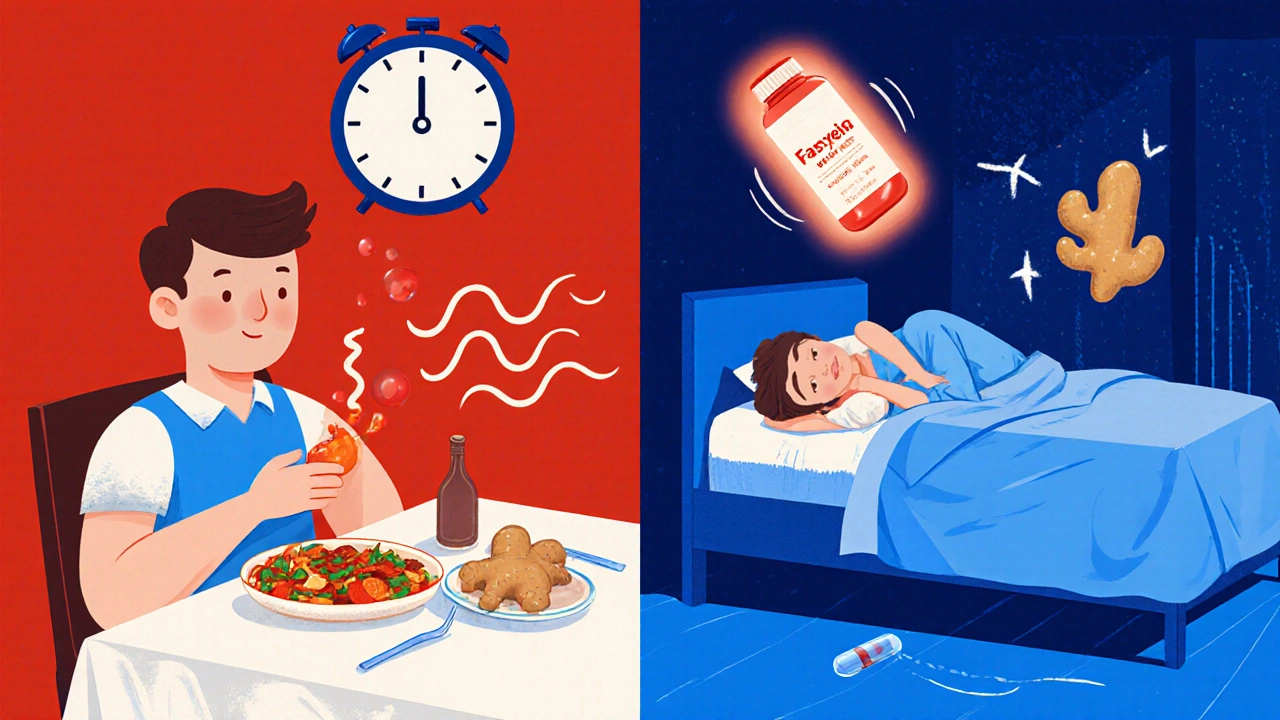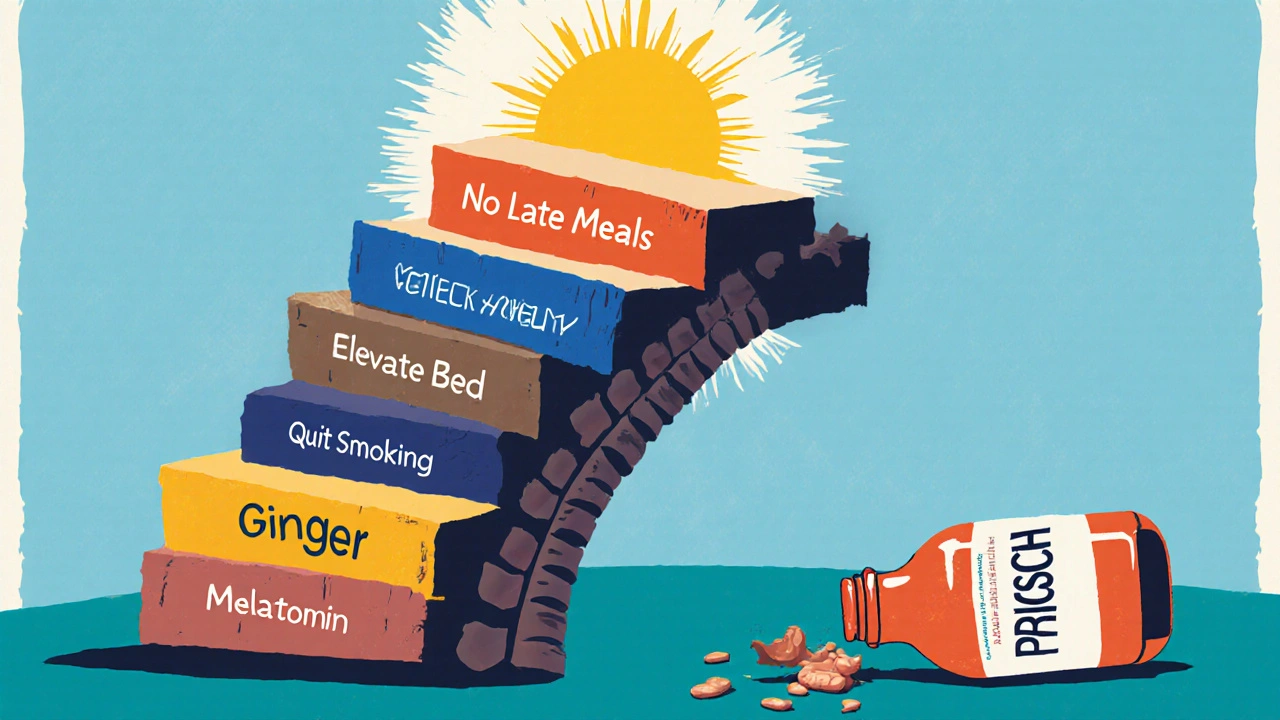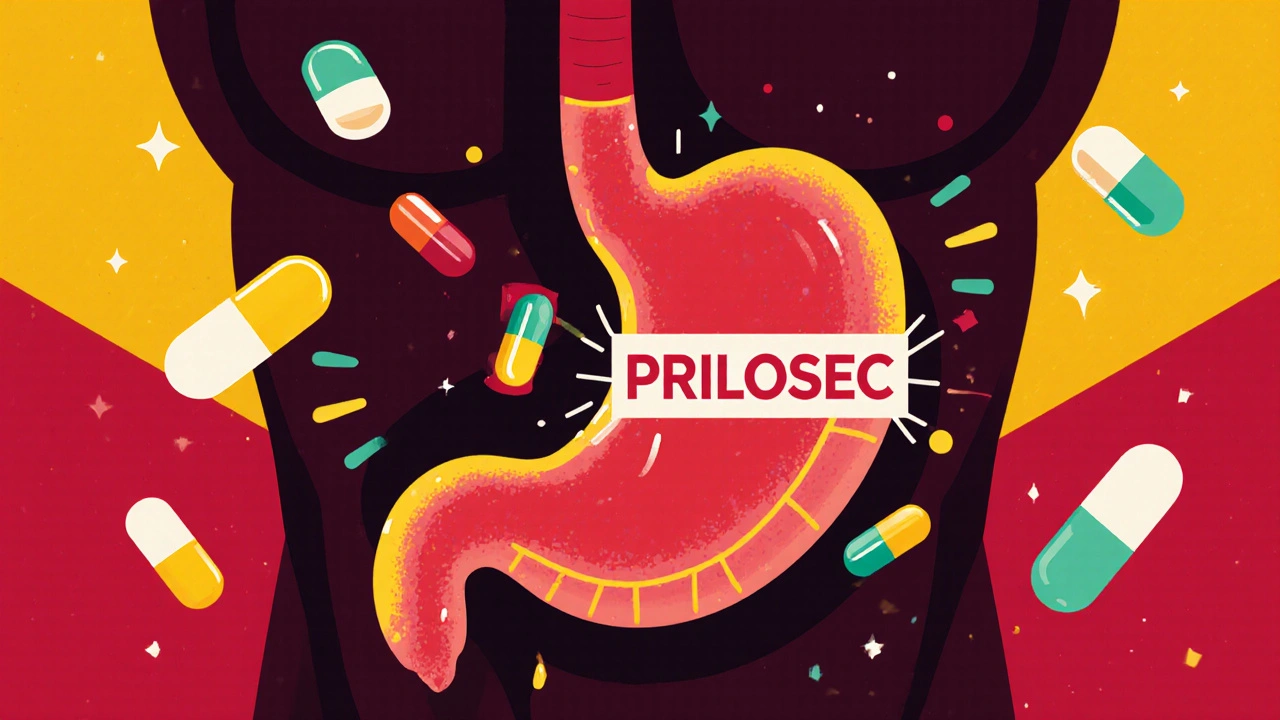If you’ve been taking Prilosec for heartburn or acid reflux, you’re not alone. Millions rely on it every day. But what if it’s not working as well as it used to? Or maybe you’re worried about long-term side effects? You’re probably wondering: Prilosec has alternatives - but which ones actually work better, safer, or cheaper?
What Prilosec (Omeprazole) Really Does
Prilosec is the brand name for omeprazole, a proton pump inhibitor (PPI). It works by shutting down the acid pumps in your stomach lining. Less acid means less burning, less regurgitation, and fewer ulcers. It’s been around since the 1980s and is one of the most prescribed drugs in the world.
It’s available over-the-counter in 20 mg doses in the UK and US. Prescription strengths go up to 40 mg. Most people take it once a day, 30 to 60 minutes before breakfast. The effects last 24 hours, which is why it’s so popular.
But here’s the catch: PPIs like Prilosec aren’t meant for daily use beyond 14 days unless your doctor says so. Long-term use has been linked to lower magnesium levels, increased risk of bone fractures, and even a higher chance of gut infections like C. diff. That’s why many people start looking for alternatives - not because they don’t work, but because they want to reduce dependency.
Other Proton Pump Inhibitors (PPIs)
Prilosec isn’t the only PPI on the shelf. There are five others approved for use in the UK and US, each with small differences in how they’re absorbed, how long they last, and how much they cost.
Here’s how they stack up:
| Drug Name | Brand Name | Typical Dose | Onset of Action | Cost (UK, 28-day supply) | Key Advantage |
|---|---|---|---|---|---|
| Omeprazole | Prilosec, Losec | 20 mg daily | 1-4 days | £12-£18 | Most widely studied, generic available |
| Esomeprazole | Nexium | 20-40 mg daily | 1-3 days | £25-£35 | Slightly stronger acid control |
| Lansoprazole | Prevacid | 15-30 mg daily | 1-2 days | £15-£22 | Faster absorption, good for quick relief |
| Pantoprazole | Protonix | 40 mg daily | 2-3 days | £14-£20 | Lower interaction risk with blood thinners |
| Rabeprazole | AcipHex | 20 mg daily | 1 day | £20-£28 | Fastest acting PPI |
So is Nexium better than Prilosec? Studies say yes - but only slightly. A 2023 meta-analysis in the British Journal of Clinical Pharmacology found esomeprazole reduced acid exposure by 5-7% more than omeprazole over 24 hours. That’s meaningful for people with severe GERD, but not enough to justify the double price for most.
Lansoprazole and rabeprazole kick in faster. If you’re looking for quicker relief, they’re worth trying. Pantoprazole is the safest if you’re on blood thinners like warfarin - it has fewer drug interactions.
H2 Blockers: The Middle Ground
If PPIs feel like overkill, H2 blockers might be your sweet spot. These drugs - like ranitidine (no longer sold in the UK due to contamination), famotidine, and cimetidine - reduce acid production but don’t shut it down completely.
Famotidine (Pepcid) is the most popular today. You can buy it over the counter in 10 mg or 20 mg doses. It starts working in 15-30 minutes and lasts up to 12 hours. That makes it perfect for nighttime heartburn or after a spicy meal.
Here’s how it compares to Prilosec:
- Speed: Famotidine works faster - great for sudden flare-ups.
- Duration: Prilosec lasts longer - better for all-day control.
- Effectiveness: PPIs reduce acid by 80-90%. H2 blockers do 60-70%.
- Safety: H2 blockers have fewer long-term risks. No known link to bone loss or nutrient deficiencies.
Many people use both: a PPI in the morning for baseline control, and famotidine at night if symptoms return. That’s a common strategy among gastroenterologists for moderate to severe GERD.

Lifestyle Changes That Work Better Than Pills
Here’s something most doctors won’t tell you: for many people, acid reflux isn’t caused by too much stomach acid - it’s caused by how food moves through the body.
Research from the University of Edinburgh in 2024 tracked 1,200 patients with mild GERD. After 12 weeks of simple lifestyle changes - no pills - 68% saw major improvement. Here’s what worked:
- Stop eating 3 hours before bed. Lying down with a full stomach lets acid creep up.
- Elevate the head of your bed 6-8 inches. Gravity helps keep acid where it belongs.
- Avoid trigger foods: Coffee, chocolate, citrus, spicy dishes, and fatty meals are common culprits.
- Loosen your belt. Tight clothes increase pressure on your stomach.
- Quit smoking. Smoking weakens the lower esophageal sphincter - the valve that keeps acid down.
One patient I spoke to in Edinburgh - a 52-year-old teacher - stopped her daily Prilosec after switching to these habits. She lost 15 pounds, cut out late-night snacks, and now only uses an H2 blocker once a week. She says she feels more in control than ever.
What About Natural Remedies?
Apple cider vinegar? Aloe vera juice? Licorice root? You’ve probably heard these touted online.
Here’s the truth: none of them have strong clinical proof. A 2022 review in the Journal of Gastroenterology looked at 17 natural remedies for GERD. Only two showed any consistent benefit - ginger and melatonin.
Ginger, in doses of 500 mg before meals, reduced nausea and improved stomach emptying in 60% of participants. Melatonin (3 mg at bedtime) helped regulate the esophageal sphincter and improved sleep in people with nighttime reflux.
But don’t expect miracles. These aren’t replacements for medication if you have erosive esophagitis or Barrett’s esophagus. They’re supportive tools - like adding a second pillow to your bed.

When to Switch from Prilosec
You don’t need to quit Prilosec just because you can. But here are signs it’s time to reconsider:
- You’ve been on it for more than 8 weeks without a doctor’s review.
- You’re taking it daily just to feel "normal."
- You’ve developed new symptoms: bloating, diarrhea, muscle cramps, or fatigue.
- You’re on other medications - especially antibiotics, antifungals, or blood thinners.
- It’s not working anymore. Tolerance can develop over time.
If any of these apply, talk to your GP. They might suggest switching to another PPI, trying an H2 blocker, or even referring you for an endoscopy to check for damage.
The Bottom Line: What Should You Do?
Prilosec works. But it’s not the only option - and it’s not always the best.
For occasional heartburn? Try famotidine or lifestyle changes first. They’re cheaper, safer, and often just as effective.
For daily, persistent reflux? Stick with a PPI - but choose the cheapest generic: omeprazole. There’s no need to pay extra for Nexium unless your doctor says so.
And if you’ve been on Prilosec for years? Don’t stop cold turkey. That can cause rebound acid hypersecretion - your stomach overcompensates and makes even more acid. Instead, work with your doctor to taper down slowly while adding in H2 blockers or lifestyle tweaks.
The goal isn’t to avoid medicine forever. It’s to use it wisely - only as much as you need, and no more.
Is omeprazole the same as Prilosec?
Yes. Prilosec is the brand name for omeprazole. The generic version works exactly the same way. Most people save money by switching to generic omeprazole - it’s just as effective and costs about half as much.
Can I take Prilosec and famotidine together?
Yes, many people do. Prilosec reduces acid production over the long term, while famotidine gives quick relief when symptoms pop up. Doctors often recommend this combo for patients with nighttime reflux or those trying to taper off PPIs.
What’s the safest long-term acid reflux treatment?
There’s no perfect long-term drug. But lifestyle changes - eating earlier, avoiding triggers, losing weight, and elevating your bed - are the safest. If you need medication, H2 blockers like famotidine carry fewer risks than daily PPIs over years.
Why does acid reflux come back after stopping Prilosec?
Your stomach ramps up acid production when you stop PPIs suddenly. This is called rebound acid hypersecretion. It’s temporary - usually lasts 2-4 weeks - but can feel worse than before. Always taper off slowly under medical supervision.
Are there any natural alternatives that really work?
Ginger and melatonin have some evidence for reducing reflux symptoms, but they’re not substitutes for medical treatment. Lifestyle changes - like not eating before bed and losing weight - are far more effective than any herbal remedy.
How do I know if I need an endoscopy?
If you’ve had heartburn for more than 5 years, have trouble swallowing, lose weight unexpectedly, or vomit blood, you should get an endoscopy. These could be signs of esophagitis or Barrett’s esophagus - conditions that need monitoring.
Next Steps: What to Try Today
Don’t wait for a doctor’s appointment to make a change. Here’s what you can do right now:
- Check your medicine cabinet. If you have Prilosec, note how long you’ve been taking it.
- Start a food and symptom journal for 7 days. Note what you eat and when heartburn hits.
- Try eating dinner at least 3 hours before bed. See if it helps.
- If you’re on daily PPIs, ask your pharmacist if switching to generic omeprazole saves money.
- Buy a pack of famotidine (Pepcid) and keep it on hand for flare-ups.
Small changes add up. You don’t need to fix everything at once. Just pick one thing and stick with it for two weeks. That’s how most people find relief - without relying on pills forever.


Beth Banham
November 8, 2025 AT 00:59I switched from Prilosec to generic omeprazole last year and saved like $40 a month. No difference in how I feel. Also started not eating after 7pm and my nighttime heartburn vanished. Small changes, big difference.
Also, don’t panic if you stop PPIs cold-your stomach will scream for a bit. Took me 3 weeks to feel normal again. Tapering helps, but honestly, just give it time.
Brierly Davis
November 8, 2025 AT 01:48Yessss!! I was on Prilosec for 5 years like a zombie. Then I tried famotidine at night + stopped late-night pizza. Boom. No more burning. I still keep Pepcid in my purse like a superhero snack. 🙌
Also, elevating my bed with books under the legs was the weirdest thing that worked. No joke. I feel like a medieval noble now, but hey-no more acid in my throat at 3am.
Amber O'Sullivan
November 9, 2025 AT 05:17Why are people still paying for Nexium when omeprazole is half the price and the same thing? This is just pharma playing you. Also ginger doesn't fix your diet. Stop looking for magic potions and just stop eating chocolate at midnight. Duh.
Jim Oliver
November 9, 2025 AT 14:03Of course you're still on Prilosec. You're one of those people who thinks 'natural remedies' are a substitute for medical science. Ginger? Melatonin? Are you kidding me? You're not 'healing'-you're just delaying the inevitable esophagitis. Also, you're probably still drinking coffee at 11pm. Stop lying to yourself.
William Priest
November 11, 2025 AT 12:15Prilosec? More like Prilosec™️. Honestly if you're still using brand name you're either rich or dumb. Generic omeprazole is literally the same molecule. Also famotidine is the real MVP. I take it before spicy food like it's a pre-game ritual. No cap. And yes I know what a PPI is. I read the FDA label. You didn't.
Ryan Masuga
November 12, 2025 AT 01:46Just wanted to say-this post saved me. I’ve been on PPIs since 2020 and didn’t even know about rebound acid. I started tapering last month with famotidine at night and eating dinner by 7. I’ve only had one flare-up in 6 weeks. It’s not perfect but I feel like I’m finally in charge. You don’t need to be perfect, just consistent. Small steps. You got this.
Jennifer Bedrosian
November 12, 2025 AT 10:21I CRIED reading this because I’ve been on Prilosec for 8 years and I didn’t realize it was making me tired and bloated and my skin was breaking out?? I stopped cold turkey last week and now I feel like a ghost with acid in my throat but I’m SO proud of myself. I’m doing the bed thing and no coffee after noon and I swear I’m already better. This is my new chapter. #acidrefluxwarrior
Lashonda Rene
November 12, 2025 AT 17:02I used to take Prilosec every day and then I started drinking aloe vera juice every morning and I swear it helped a little but then I read that it might not be safe long term so I stopped that and then I tried apple cider vinegar but that burned my throat so I stopped that too and then I just started not eating right before bed and honestly I think that’s what really helped because now I only take Pepcid like once a month and I feel way better and I’m not scared of the pills anymore even though I still take them sometimes because I’m not perfect and that’s okay
Andy Slack
November 13, 2025 AT 14:59Just dropped my Prilosec prescription at the pharmacy and got the generic. Saved $32. Walked home. Ate dinner at 6. Slept like a log. No emoji. No hype. Just facts. You don’t need a miracle. You just need to stop eating like a raccoon at midnight.